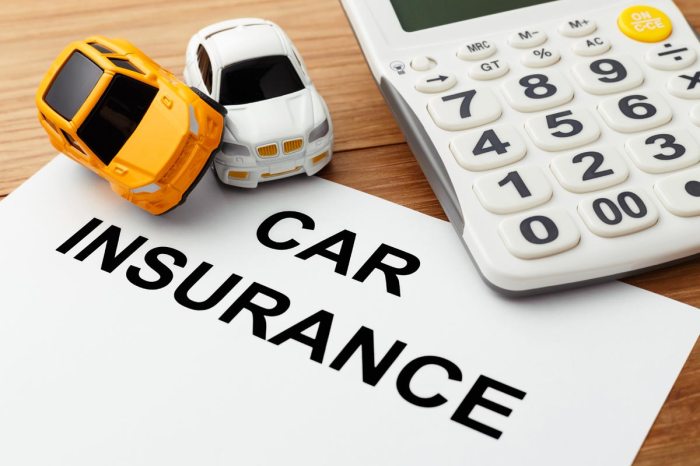
Delve into the intricacies of car insurance policies as we explore the various facets that make up this crucial aspect of vehicle ownership. From understanding the purpose to navigating the complexities of coverage options, this guide is designed to equip you with the knowledge needed to make informed decisions.
Embark on a journey that demystifies the world of car insurance policies, shedding light on key components and factors that influence premiums, ultimately empowering you to choose the right coverage for your needs.
Understanding Car Insurance Policy
Car insurance policy is a contract between the policyholder and the insurance company to provide financial protection in case of accidents, theft, or other damages related to the insured vehicle.
Key Components of a Car Insurance Policy
- Liability Coverage: Protects the policyholder from financial loss if they are responsible for causing injury or property damage to others in an accident.
- Collision Coverage: Covers the cost of repairs or replacement of the insured vehicle if it is damaged in a collision with another vehicle or object.
- Comprehensive Coverage: Provides coverage for damages to the insured vehicle that are not caused by a collision, such as theft, vandalism, or natural disasters.
- Uninsured/Underinsured Motorist Coverage: Protects the policyholder if they are involved in an accident with a driver who does not have insurance or enough insurance to cover the damages.
Types of Coverage Options in a Car Insurance Policy
- Personal Injury Protection (PIP): Covers medical expenses for the policyholder and passengers regardless of who is at fault in an accident.
- Rental Reimbursement: Provides coverage for rental car expenses while the insured vehicle is being repaired after a covered accident.
- Roadside Assistance: Offers services like towing, battery jump-start, and tire changes in case of vehicle breakdown.
Factors Influencing Car Insurance Policy Premiums
When it comes to determining car insurance premiums, several factors come into play. Understanding how these factors influence the cost of your policy can help you make informed decisions when choosing coverage.
Type of Vehicle
The type of vehicle you drive can have a significant impact on your car insurance premium. Generally, vehicles with a higher value, more powerful engines, or those that are more expensive to repair or replace will result in higher premiums.
This is because these types of vehicles are considered to be at a higher risk of being involved in accidents or theft.
Driving History
Your driving history is another crucial factor that insurers consider when calculating your car insurance premium. A history of accidents, traffic violations, or DUI convictions can signal to insurers that you are a high-risk driver, leading to higher premiums. On the other hand, a clean driving record with no claims can result in lower premiums as you are seen as a lower risk to insure.
Location and Demographics
Where you live and your demographics can also influence your car insurance rates. Urban areas with higher rates of accidents or theft may result in higher premiums compared to rural areas. Additionally, factors like age, gender, marital status, and credit score can also impact your premium.
For example, younger drivers or those with poor credit may face higher rates compared to older, married individuals with good credit.
Choosing the Right Coverage

When selecting car insurance coverage, it's essential to consider your needs and budget to ensure you are adequately protected while driving on the road.
Comprehensive Coverage vs. Collision Coverage
- Comprehensive Coverage: This type of coverage protects your vehicle from damages not caused by a collision, such as theft, vandalism, natural disasters, or hitting an animal.
- Collision Coverage: Collision coverage pays for damages to your car resulting from a collision with another vehicle or object, regardless of fault.
Determining Appropriate Coverage Limits
- Assess your car's value and consider how much you can afford to pay out of pocket in case of an accident.
- Review state minimum requirements but opt for higher limits if necessary to protect your assets.
- Factor in the cost of medical expenses and potential lawsuits when determining liability coverage limits.
Importance of Additional Coverage Options
- Roadside Assistance: This coverage provides help if your car breaks down on the road, offering services like towing, fuel delivery, and tire changes.
- Rental Car Reimbursement: In case your car is in the shop for repairs after an accident, this coverage helps cover the cost of a rental vehicle.
Making Claims and Understanding Policy Terms
When it comes to car insurance, understanding how to make claims and the terms used in the policy is crucial for a smooth process and to ensure you are adequately covered. Let's dive into the steps involved in filing a car insurance claim and define common terms used in car insurance policies
Filing a Car Insurance Claim
- Notify your insurance company: Contact your insurance provider as soon as possible to report the incident and initiate the claims process.
- Gather information: Collect all relevant details such as the other party's information, police report (if applicable), and any documentation related to the claim.
- Submit claim form: Fill out the necessary claim form provided by your insurance company and submit it along with the required documents.
- Assessment: An adjuster will assess the damage and determine the coverage and payout based on your policy.
- Resolution: Once the assessment is complete, your insurance company will provide a resolution and process the claim accordingly.
Understanding Policy Terms
- Deductible:The amount you are required to pay out of pocket before your insurance coverage kicks in. For example, if your deductible is $500 and the total repair cost is $2000, you will pay $500, and the insurance company will cover the remaining $1500.
- Premium:The amount you pay to the insurance company in exchange for coverage. Premiums are typically paid monthly, semi-annually, or annually.
- Liability:Refers to your legal responsibility for bodily injury or property damage caused to others in an accident where you are at fault.
Reviewing and Understanding Policy Fine Print
Reading and understanding the fine print of your car insurance policy is essential to know what is covered, excluded, and any limitations. Pay attention to details such as coverage limits, exclusions, deductibles, and additional benefits. If you have any questions or are unsure about certain terms, don't hesitate to reach out to your insurance provider for clarification.
Renewing and Modifying Car Insurance Policies
Renewing and modifying car insurance policies are crucial steps in ensuring that your coverage remains up-to-date and meets your evolving needs. It is important to understand the best practices for renewing your policy, the process of modifying coverage, and how to negotiate better rates or discounts.
Renewing Your Car Insurance Policy
When it comes time to renew your car insurance policy, it is essential to review your current coverage and assess if any changes are needed. Consider factors such as changes in your driving habits, the value of your vehicle, and any new discounts that may be available.
It's also a good idea to shop around and compare quotes from different insurance providers to ensure you are getting the best deal.
Modifying Your Car Insurance Policy
If you need to modify your car insurance policy to add or remove coverage, contact your insurance provider to discuss your options. Whether you need to adjust your deductible, add comprehensive coverage, or remove a specific type of coverage, your provider can help you navigate the process.
Keep in mind that modifying your policy may impact your premium, so be sure to ask about any potential cost changes.
Negotiating Better Rates or Discounts
When renewing your car insurance policy, don't be afraid to negotiate for better rates or discounts. If you have a good driving record, completed a defensive driving course, or have multiple policies with the same provider, you may be eligible for discounts.
Additionally, consider increasing your deductible or bundling your policies to potentially lower your premium. Be proactive and communicate with your insurance provider to explore all available options for saving money on your car insurance.
Final Wrap-Up
In conclusion, the realm of car insurance policies is vast and multifaceted, but armed with the information provided in this guide, you can confidently navigate the nuances of selecting, renewing, and modifying your policy. Stay informed, stay protected, and drive with peace of mind.
User Queries
What is the purpose of a car insurance policy?
A car insurance policy provides financial protection in case of accidents, theft, or damage to your vehicle.
How does driving history impact car insurance premiums?
Having a clean driving record typically results in lower premiums, while accidents and traffic violations can lead to higher costs.
What are the key components of a car insurance policy?
The key components include liability coverage, collision coverage, comprehensive coverage, and uninsured/underinsured motorist coverage.
How can I negotiate better rates when renewing my car insurance policy?
You can explore discounts for safe driving, bundling policies, or maintaining a good credit score to potentially lower your rates.
What are the common terms used in car insurance policies?
Common terms include deductible (the amount you pay before insurance kicks in), premium (the cost of the policy), and liability (coverage for damages you cause to others).














